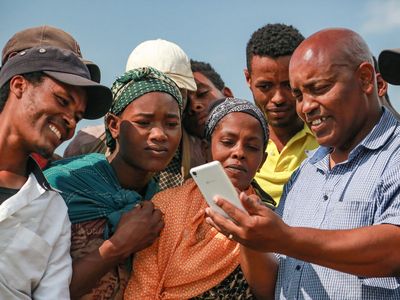Capturing Knowledge for Driving Results

This post is written by Simegnew Eshetie Mitiku, M&E Specialist, FTFE VCA
For KNOWvember at Fintrac, staff around the world convene virtually to reflect on our knowledge - how we produce it and use it - for stronger agricultural development results. This is the third in a series about monitoring, evaluation, and learning as part of that effort (read the first and second ones here and here). For more information, contact [email protected].
As a monitoring and evaluation (M&E) specialist on the Feed the Future Ethiopia Value Chain project (FTFE-VCA), I work in the Amhara region to collect, analyze, and report data on our progress. At Fintrac, we have a strong data management system in which data is stored and later accessed for reporting and adaptive management.
Every program participant – including participants in field days (such as Fall Armyworm and good  agricultural practices); business to business events (with smallholders and local buyers); and trainings (such as clean milk production) – is registered in CIRIS. M&E data entry specialists input data captured through attendance logs to trace the benefits of the project, and also to troubleshoot where we may need to adapt our activities. This database is one of the most important tools for my job.
agricultural practices); business to business events (with smallholders and local buyers); and trainings (such as clean milk production) – is registered in CIRIS. M&E data entry specialists input data captured through attendance logs to trace the benefits of the project, and also to troubleshoot where we may need to adapt our activities. This database is one of the most important tools for my job.
From CIRIS we generate different types of information based on the key program indicators. We work with farmers every day, in all country target regions, and thus every day new data is entered into the system. This information is focused on specific value chains, such as maize, coffee, chickpea, dairy, meat and live animal, and poultry. We then take the information and, working with colleagues at our main project office in Addis Ababa, create visualizations to highlight our progress towards targets.
Adaptive Management Needs to Be Based on Regular and Timely Information
To be able to act on the data we’re collecting, we monitor the number of participants we are reaching every day. Sometimes the data is not entered immediately because of the distance between our activities and field offices. However, we are also always finding ways to maintain or even speed up data entry efforts. This helps us get the data available for processing and generating the knowledge our staff and stakeholders can use. Importantly, we then display it visually so that team members can understand and take quick action.
For field staff, seeing the status for each region side-by-side generates lighthearted competition because they each want their target value chain to succeed. We see which regions and value chains are reaching or exceeding their respective targets, and notably, which ones are falling behind. This makes it possible for our value chain advisors to take stock and adjust their strategies to go from lagging to achieving the targets. As they do, their region may outperform another, creating a new milestone for other regions to meet.
For example, in the Amhara region, we made strong progress in maize, chickpea, and also the MLA value chains. However, we lagged in achieving dairy-related targets because of the time required to start up the project. When the dairy specialist in Amhara realized that the dairy achievements were lower there than in other regions, he became motivated to close this gap. He questioned why the lag was happening, and then discussed all the possible reasons with the Amhara team, colleagues in other regions, and our Addis Ababa main office. As a result, the dairy team intensified the implementation of activities and now FTFE-VCA in Amhara is catching up in dairy-related activities.
For all project stakeholders in Amhara, specifically farming communities, our government and private sector counterparts, and external experts, seeing the analysis and findings helps them to focus on key priorities. We discuss the information in joint review and learning meetings, strategize on coordinated efforts to improve our progress towards outcomes, and establish a path forward to speed up implementation.
